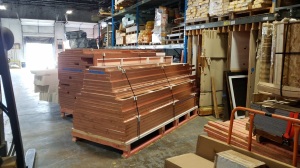by
John R. Fischer, Senior Reporter | October 09, 2019

Radiofrequency shields are often constructed of copper, galvanized steel or aluminum, all of which carry distinct advantages.
From the October 2019 issue of HealthCare Business News magazine
Constructing a successful MR suite is expensive business, but in the long run it’s not as expensive as constructing a suite with fundamental design flaws. Perhaps no area of the planning process is as important, or as easily overlooked, as the radiofrequency (RF) shield, which keeps out scan-distorting interference. If not planned in advance, the installation of this structure adds unnecessary expenses and confusion to the project, as well as delays to site completion and patient exams.
“Everyone is left scrambling to figure out how to accommodate the shielding into the construction process,” Joel Kellogg, director of engineering for Field Management Services, told HCB News. “From an actual installation perspective, some of the most common mistakes revolve around coordination of all the different disciplines, because you may have acoustic or vibration requirements. Even just for MEP [mechanical, electrical and plumbing] requirements, putting off shielding considerations will lead to some installation challenges.”
There are a lot of questions that need to be asked before embarking on a shielding job. Even when a shield is in place there are right and wrong ways to maintain it, but a well maintained shield can last a long while — even beyond the lifetime of the equipment.



Ad Statistics
Times Displayed: 128996
Times Visited: 7335 MIT labs, experts in Multi-Vendor component level repair of: MRI Coils, RF amplifiers, Gradient Amplifiers Contrast Media Injectors. System repairs, sub-assembly repairs, component level repairs, refurbish/calibrate. info@mitlabsusa.com/+1 (305) 470-8013
The right shielding material
Choosing a shielding material depends on the provider’s environment, budget and what they desire to get out of their shield. Copper is considered by many to be the best choice due to the longevity of its seam integrity versus galvanic corrosion, its price and ease of workmanship. It also is well-suited for sites that operate with regular noise frequencies due to its inherent electrical properties.
“Galvanized steel and aluminum metals are better materials for lower frequencies,” said David Geiger, VP of sales for Americas at ETS-Lindgren, adding that the “selection of a material is defined by the equipment vendor and by site-specific noise that they have to attenuate.”
Often supporting copper shields are wood frames that make it light, easy to carry on-site and easy to modify. Any RF shield that utilizes wood, however, is also vulnerable to water damage, with moisture from RF leaks, humidity and even air conditioning causing the wood to swell and the RF seal to break. Aluminum, in contrast, does not require a wooden structure, making it resilient to water damage. It also can create self-standing structures that can be easily disassembled and modified over time. Aluminum shielding panels, however, can rarely be modified on site if needed.

